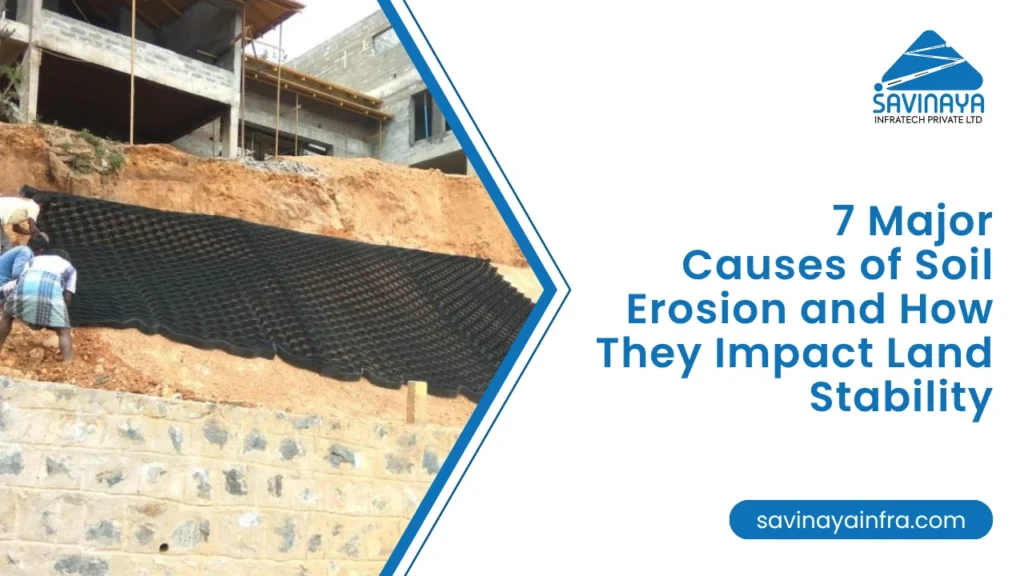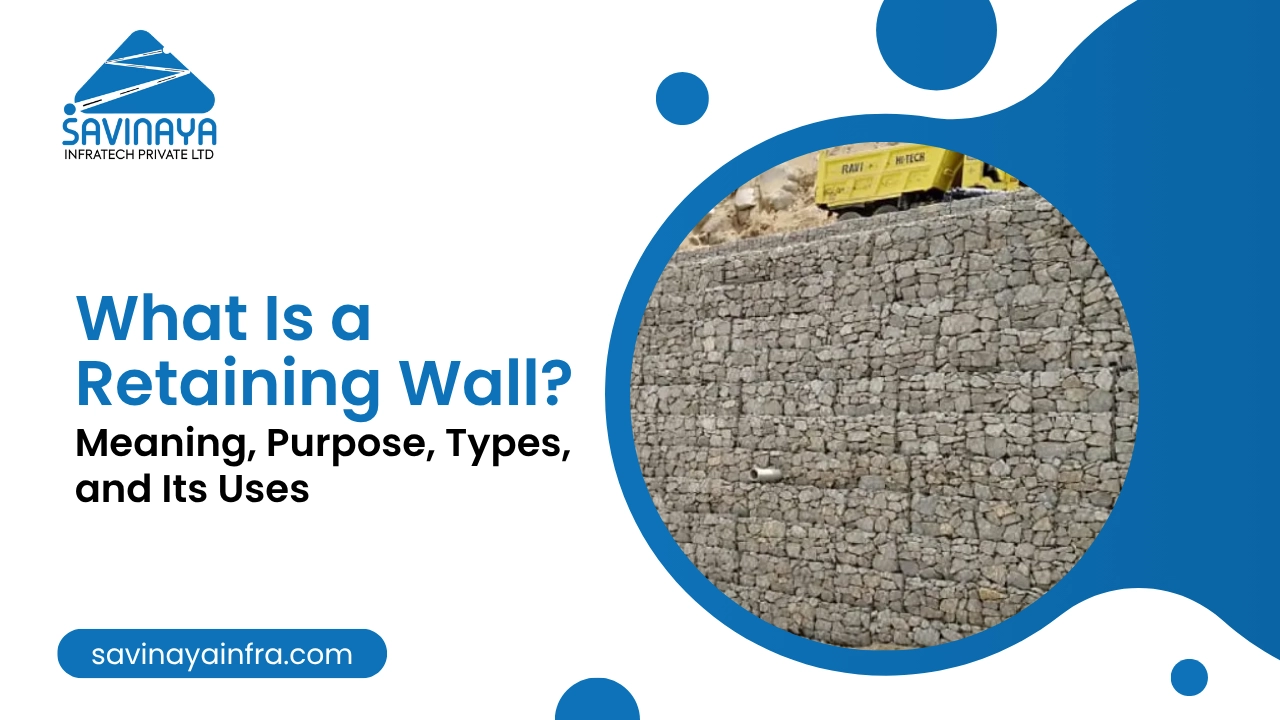Most people think land gives way suddenly. In reality, it starts much earlier, often with signs we ignore. Cracks on a slope, muddy runoff during rain, exposed tree roots: these are the quiet warnings of soil erosion.
But what really causes the ground to break apart and shift? And more importantly, how does it affect the stability of infrastructure, especially in regions with challenging landscapes?
This article explores the 7 major causes of soil erosion, the damage it leaves behind, and what can be done to stop it before it turns into a crisis.
Key Takeaways
- Soil erosion is a silent threat to land stability, infrastructure, and ecosystems especially in hilly or high-rainfall zones.
- The seven main causes include water runoff, wind erosion, deforestation, construction activity, overgrazing, urban development, and slope instability.
- Different types of soil erosion (sheet, rill, gully, splash, and wind) affect land in various ways and require targeted solutions.
- Erosion leads to foundation failures, landslides, sedimentation, and agricultural decline making early prevention critical.
- Proven control methods include soil nailing, shotcreting, drainage systems, retaining walls, and vegetation cover.
Table of Contents
What Is Soil Erosion?
Soil erosion is the natural or human-induced process where the upper layer of soil is displaced by wind, water, or other environmental factors. Over time, this leads to a loss of fertile topsoil, reduced land productivity, and instability in the earth’s surface particularly on slopes and construction sites. This issue is especially critical in geotechnical and foundation projects, where erosion can directly impact structural integrity and site safety.
7 Main Causes of Soil Erosion and How Does It Affect Land Stability
Soil erosion poses a major risk to both land and structural stability. Here are the seven leading causes of soil erosion and how they impact on construction and development:
1. Water Runoff
Heavy rainfall or poor drainage systems cause surface water to wash away loose soil. On construction sites, uncontrolled runoff leads to foundation exposure and slope failure.
2. Wind Erosion
In arid regions, strong winds displace dry, fine particles of soil, reducing surface stability and increasing dust hazards.
3. Deforestation
The removal of vegetation eliminates natural root systems that bind soil together. This is especially damaging on hilly terrain where roots prevent landslides and surface collapse.
4. Construction Activities
Excavation, grading, and other site preparation activities disturb the soil structure. Without proper stabilization, this leads to rapid erosion, especially during rain or storms.
5. Overgrazing and Agriculture
Repeated animal grazing and poor farming practices degrade soil quality, causing surface layers to become loose and easily eroded.
6. Urban Development
Replacing natural landscapes with impervious surfaces (like concrete) increases surface runoff and destabilizes adjacent soils.
7. Slope Instability
Natural slopes, if not reinforced, are prone to sliding—particularly during rains or earthquakes. Erosion on slopes can lead to landslides and structural damage.
What are the Types of Soil Erosion?
Soil erosion doesn’t look the same everywhere. Depending on the landscape and weather, it can take different forms. Let’s understand the types of soil erosion commonly seen across construction and natural environments.
1. Sheet Erosion
This is a slow, often unnoticed process. A thin layer of topsoil is removed uniformly across a wide area, especially after light rains. Over time, this weakens the soil’s structure.
2. Rill Erosion
As water gathers on the surface, it starts forming small channels or rills. These tiny flows cut into the soil and grow deeper with each rainfall.
3. Gully Erosion
When rills deepen, they become gullies; large, visible cuts in the land that are difficult to repair. This form of erosion can quickly destabilize slopes and structures.
4. Wind Erosion
In dry, open areas, wind can lift fine particles off the ground and carry them away. This type of erosion is especially common in flat plains and deserts.
5. Splash Erosion
This occurs when raindrops hit bare soil directly, breaking up soil particles and starting the erosion process at a micro level.All these kinds of soil erosion slowly reduce land strength and make it less reliable for construction, agriculture, or environmental stability.
Effects of Soil Erosion on Infrastructure and Ecosystems
When erosion takes hold, the damage spreads across everything that stands on the land. Let’s break down the effects of soil erosion in real-world terms.
1. Weakened Infrastructure
Roads, buildings, retaining walls, and embankments lose their ground support. Cracks, tilts, and collapses often follow. In hilly areas, even a minor slope shift can result in major failures.
2. Landslides
One of the most dangerous outcomes of unchecked erosion. Loose soil combined with water pressure can trigger massive slope failures.
3. Sedimentation in Waterways
As soil is carried downhill, it clogs rivers, lakes, and drainage systems. This affects both water quality and aquatic ecosystems.
4. Loss of Vegetation
Without stable soil, plant roots can’t hold. Vegetation dies off, and the landscape becomes barren, making the area even more vulnerable.
5. Agricultural Loss
In rural areas, erosion removes the topsoil that holds nutrients. This leads to poor crop yields and long-term land degradation.
The overall soil erosion impact is not just environmental, but also deeply economic and social. Once erosion begins, it becomes difficult — and expensive — to reverse.
Interesting reads: How Rockfall Protection Systems Prevent Landslides
How Can You Prevent Soil Erosion on Hill Slopes and Construction Sites?
If you are working on a hilly site or unstable soil, ignoring erosion is not an option. You need reliable methods to prevent soil erosion that match the land’s character and the project’s demands. Here’s what works:
1. Soil Nailing
This is one of the most trusted techniques. Steel bars are drilled into the slope and fixed with grout. This holds the loose soil together and reinforces the structure. It’s perfect for hill roads, retaining walls, and cut slopes.
2. Shotcreting (Gunite)
This technique involves spraying a layer of shotcrete (also known as gunite) over the slope’s surface. It forms a protective shell that guards against erosion from rainfall and surface runoff, while also improving slope stability. Shotcreting is especially useful for steep or rocky terrain where traditional vegetation methods may not work effectively.
3. Vegetation and Geo-Matting
Fast-growing grasses, shrubs, and geotextile mats help protect the surface from rainfall and surface runoff. This is one of the simplest ways to prevent soil erosion, especially in areas that need quick, natural cover.
4. Retaining Structures
Gabion walls, crib walls, or reinforced soil structures create physical barriers. These help in soil retention and reduce erosion caused by water flow or wind.
5. Drainage Systems
Uncontrolled water is one of the biggest natural causes of soil erosion. A proper surface and subsurface drainage system channels water safely away from the slope or site, reducing pressure on the soil.
Why Choose Savinaya Infratech for Soil Stabilization and Erosion Control Solutions?
When it comes to understanding the causes of land erosion, Savinaya Infratech goes far beyond the basics. We don’t just respond to erosion issues — we prevent them from happening in the first place.
Here’s why engineers, developers, and government bodies across India trust us:
1. Project Experience
From mining sites in Odisha to National Highway projects, we’ve stabilized some of the most complex slopes in the country.
2. Full-Scope Services
Whether you need soil nailing services, gabion wall construction, slope regrading, or full erosion control design, we handle it all under one roof.
3. Technical Expertise
Our team understands how soil erosion means more than surface damage. We analyze the underlying geology and match it with the right solution.
4. Site-Specific Solutions
Every hill, every slope, and every construction zone is different. We don’t use templates — we use tailored geo-tech engineering.
By choosing Savinaya Infratech, you choose a partner who understands the main causes of soil erosion and delivers lasting protection from them.
Conclusion
Soil erosion is more than a surface issue. It’s a deep, often invisible problem that eats away at the land’s stability. The reasons for soil erosion are many: heavy rains, deforestation, unplanned construction, and wind. But understanding these problems allows us to plan. And prevention is always better than rebuilding after collapse. a If your land shows signs of movement, or you’re starting a project on a slope, get the right help early.
The team at Savinaya Infratech is ready with solutions designed for your site and your safety. Contact us to discuss your project requirements.
FAQs
1. Which type of soil erosion is most dangerous for hillsides?
Gully erosion is often the most dangerous for hillsides. It creates deep cuts in the slope where water has carved through the soil, making the land unstable and prone to sudden failure. Over time, small channels grow into large gullies, which can severely weaken the slope and affect nearby structures or roads.
2. Is soil erosion the same as a landslide?
Not exactly. Soil erosion is a gradual process where water, wind, or gravity removes the top layer of soil over time. A landslide is a sudden event where a large section of land or slope collapses all at once. However, long-term erosion can weaken a slope enough to trigger a landslide, so the two are closely connected.
3. Can rainfall really cause erosion on slopes?
Yes, rainfall is one of the most common natural causes of soil erosion, especially on slopes. When rainwater flows downhill, it loosens and carries soil with it. Intense or repeated rain can quickly erode the surface and start forming rills and gullies, making the slope weaker with each downpour.
4. Can soil erosion lead to landslides or slope failures?
Absolutely. Soil erosion can reduce the stability of a slope over time, washing away the material that holds it together. As the slope becomes steeper and more exposed, the risk of landslides increases, especially after heavy rain or seismic activity. That’s why controlling erosion is a critical part of slope stabilization.
5. Does soil erosion affect buildings and foundations?
Yes, and often in ways that aren’t visible at first. Soil erosion can gradually remove the support beneath foundations, causing buildings to settle unevenly or crack. On sloped sites, erosion can also shift the ground around retaining walls or basements, leading to structural issues if not addressed in time.


